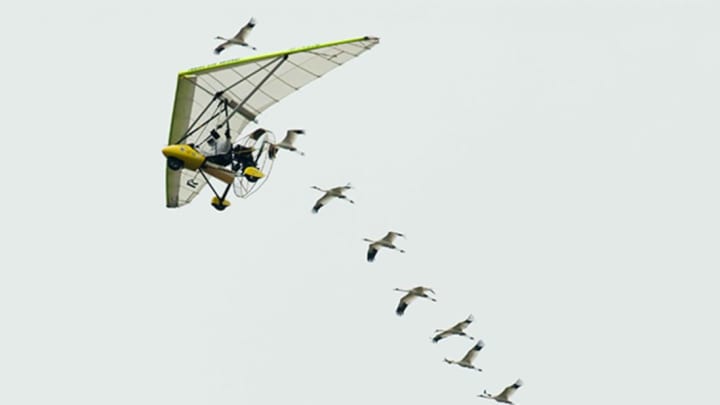Since 2001, a Canadian nonprofit called Operation Migration has been leading endangered whooping cranes to temperate winter homes, acting as surrogate parents for cranes raised in captivity and reintroduced to the wild. However, after 15 years of attempts to bolster the population of wild cranes, the federal government is pulling its funding from the program. To date, the U.S. Fish and Wildlife Service has spent more than $20 million trying to establish new flocks of the cranes.
There is only one established group of wild whooping cranes in the U.S., migrating each year between Canada and Texas. In 1941, this flock had only 15 birds, but whooping crane conservation efforts have since raised the number of wild cranes to more than 200. However, for the species to be truly stable, there can’t just be one flock of them—what would happen if disease or a natural disaster struck that group’s habitat?
In an attempt to seed new flocks of whooping cranes, Operation Migration works with crane conservation groups to raise chicks (volunteers wear crane costumes in an effort to reduce the cranes’ dependency on humans) and release them back into the wild via annual plane migrations, which last months. The most recent ultralight migration took more than 100 days.
Birds learn how to migrate from their parents, which poses a major problem for reestablishing endangered bird species. Raised without a flock of adults to follow, they don’t know how or where to migrate in the winter. Operation Migration uses ultralight aircraft to guide the cranes along a safe path; the goal is to get young birds to "imprint" on the plane as if it were their mother (much like in the 1996 movie Fly Away Home, produced by the charity’s founders).
So far, Operation Migration has released around 250 whooping cranes in Wisconsin. Only 93 have survived, and just 10 have gone on to reproduce, a number the Fish and Wildlife Service thinks is far too low to call the plane-supported reintroduction method a success. Most of the birds simply don’t acquire the parenting skills they need to help the species survive.
And so the ultralight program is coming to an end. However, efforts to bolster crane populations will continue, albeit in some new form. The Whooping Crane Eastern Partnership, a group of nonprofits and government agencies dedicated to reviving the species in North America, plans to rework its program to minimize human interaction with the birds.
[h/t: Al Jazeera America]
